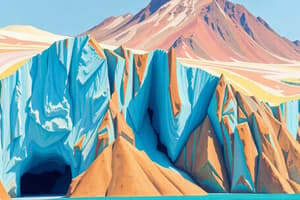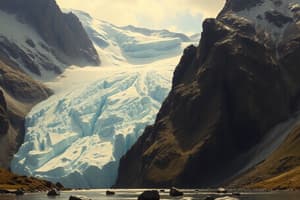Podcast
Questions and Answers
What characterized the Middle Paleolithic Era?
What characterized the Middle Paleolithic Era?
- Establishment of permanent agricultural settlements
- Appearance of complex societies with trade networks
- Development of pottery and advanced hunting tools
- Cultural developments such as jewelry, body painting, and early art (correct)
Which tool type is specifically associated with the Lower Paleolithic Era?
Which tool type is specifically associated with the Lower Paleolithic Era?
- Advanced composite tools
- Choppers and handaxes (correct)
- Ceramics and pottery
- Metal tools and implements
What significant changes occurred during the Neolithic Era?
What significant changes occurred during the Neolithic Era?
- Learning to make fire and development of more complex tools (correct)
- Invention of the wheel and the establishment of trade routes
- Transition to a fully nomadic lifestyle
- Discovery of metalworking and large-scale agriculture
What defines the Pre Pottery Phase of the Neolithic period?
What defines the Pre Pottery Phase of the Neolithic period?
Which aspect is noteworthy about the Upper Paleolithic Era?
Which aspect is noteworthy about the Upper Paleolithic Era?
What defines a glacial period?
What defines a glacial period?
What is glacial retreat?
What is glacial retreat?
What is an ice age characterized by?
What is an ice age characterized by?
What contributes to glacial ablation?
What contributes to glacial ablation?
What effect does the Ice-Albedo Effect have?
What effect does the Ice-Albedo Effect have?
Which factor is known to drive glacial-interglacial cycles?
Which factor is known to drive glacial-interglacial cycles?
What does the geological time scale reflect?
What does the geological time scale reflect?
Which of the following is not a characteristic of the Paleolithic Era?
Which of the following is not a characteristic of the Paleolithic Era?
Flashcards
Lower Paleolithic Era
Lower Paleolithic Era
The earliest phase of human prehistory characterized by the use of simple tools like choppers, handaxes, and cleavers.
Mesolithic Era
Mesolithic Era
A period marked by the development of more complex tools, including smaller and more intricate designs.
Neolithic Era
Neolithic Era
The time period when humans began using fire and created more sophisticated tools like saws and drills.
Pre Pottery Phase
Pre Pottery Phase
Signup and view all the flashcards
Pottery Phase
Pottery Phase
Signup and view all the flashcards
What is a Glacier?
What is a Glacier?
Signup and view all the flashcards
What is a Glacial Period?
What is a Glacial Period?
Signup and view all the flashcards
What is Glacial Advance?
What is Glacial Advance?
Signup and view all the flashcards
What is Glacial Retreat?
What is Glacial Retreat?
Signup and view all the flashcards
What is Glacial Ablation?
What is Glacial Ablation?
Signup and view all the flashcards
What is an Interglacial Period?
What is an Interglacial Period?
Signup and view all the flashcards
What are Milankovitch Cycles?
What are Milankovitch Cycles?
Signup and view all the flashcards
What is Glacial Maximum?
What is Glacial Maximum?
Signup and view all the flashcards
Study Notes
Glacial Processes and Periods
- Glacier: A large mass of moving ice and snow on land.
- Ice Sheet: A large mass of compressed ice.
- Glacial Period: A period of cooler climate, marked by glacier advancement.
- Ice Age: A period of extremely cold temperatures with extensive ice sheets.
- Glacial Advance: Glacier's forward movement due to more snow than ablation.
- Glacial Retreat: Glacier's backward movement due to more ablation than snow accumulation.
- Glacial Ablation: Removal of glacier ice (melting, evaporation, calving, etc.).
- Interglacial Period: Warm period between glacial periods, lasting thousands of years.
- Paleoclimate: Past climates.
- Milankovitch Cycles: Changes in Earth's orbit and tilt causing glacial cycles.
- Solar Insolation: Sun's energy received by Earth.
- Glacial-Interglacial Cycles: 50-60 million years of global cooling driven by orbital variations.
- Ice-Albedo Effect: Ice reflects sunlight, leading to more melting and warming through positive feedback.
- Glacial Maximum: Period of maximum ice sheet extent.
- Geological Time Scale: Geologists' time scale of historical periods (Precambrian, Paleozoic, Mesozoic, Cenozoic).
Human Development During Glacial Periods
- Paleolithic Era: Old Stone Age (2.5 million to 10,000 years ago). Humans focused on food, used stone and bone tools, and were nomadic hunters and gatherers.
- Lower Paleolithic Era: Early phase of this era, characterized by specific tool types (choppers, handaxes).
- Middle Paleolithic Era: Cultural developments (jewelry, art) and simple ceramics emerged.
- Upper Paleolithic Era: Earliest organized settlements, important hunting, and (50,000-10,000 years ago).
- Mesolithic Era: Middle Stone Age, smaller, more complex tools were created.
- Neolithic Era: New Stone Age, where humans learned fire and advanced tools (saws, drills).
- Pre-Pottery Phase: Early Neolithic, new subsistence strategies and permanent settlements.
- Pottery Phase: Late Neolithic, development of elaborate pottery by coastal cultures.
Studying That Suits You
Use AI to generate personalized quizzes and flashcards to suit your learning preferences.





